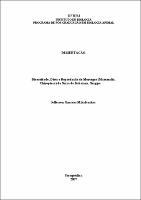Please use this identifier to cite or link to this item:
https://rima.ufrrj.br/jspui/handle/20.500.14407/10871Full metadata record
| DC Field | Value | Language |
|---|---|---|
| dc.contributor.author | Mikalauskas, Jefferson Simanas | pt_BR |
| dc.date.accessioned | 2023-12-22T01:43:56Z | - |
| dc.date.available | 2023-12-22T01:43:56Z | - |
| dc.date.issued | 2007-03-05 | |
| dc.identifier.uri | https://rima.ufrrj.br/jspui/handle/20.500.14407/10871 | - |
| dc.description.abstract | Foi estudada a composição, diversidade, dieta e reprodução de morcegos em uma comunidade situada entre os domínios morfoclimáticos da Mata Atlântica e a Caatinga de Sergipe. Foram capturados 183 morcegos de 16 espécies, com predomínio da família Phyllostomidae, especialmente da subfamília Stenodermatinae. De modo geral, as espécies capturadas estão dentro de suas áreas já conhecidas de distribuição, com exceção de Chiroderma doriae, que é considerado endêmico da região sudeste e foi coletado no presente trabalho. As espécies coletadas apresentaram diferenças significantes com relação à proporção de espécies que ocorreram exclusivamente em áreas abertas. Também houve diferenças significantes com relação à freqüência mensal de capturas, proporção de indivíduos coletados e número de espécies coletadas nos hábitats aberto e fechado. As espécies frugívoras foram predominantes. O período de atividade dos morcegos foi significantemente diferente entre os dois períodos de coleta, as quatro primeiras horas após o entardecer foi o período de maior atividade. Foram coletados 3 a 5 vezes mais indivíduos entre 18:00 24:00 horas. A razão sexual foi 1 macho para 2 fêmeas. Foram analisadas histologicamente as gônadas de 42 machos, 37 destes (88%) continham espermatozóides na luz dos túbulos seminíferos e nos epidídimos. Não houve diferenças significantes com relação à variação mensal do número de machos reprodutivos, sugerindo sincronismo reprodutivo entre os machos da comunidade estudada. Do total de fêmeas capturadas (n = 117), 79 (67,5%) estavam reprodutivas. Com exceção de A. lituratus, C. perspicillata e P. lineatus, aparentemente a distribuição mensal das fêmeas reprodutivas das demais espécies é homogênea. | por |
| dc.description.sponsorship | CAPES | pt_BR |
| dc.format | application/pdf | por |
| dc.language | por | por |
| dc.publisher | Universidade Federal Rural do Rio de Janeiro | por |
| dc.rights | Acesso Aberto | por |
| dc.subject | Chiroptera | por |
| dc.subject | diversidade | por |
| dc.subject | Mata Atlântica | por |
| dc.subject | Caatinga | por |
| dc.subject | distribuição | por |
| dc.subject | diversity | eng |
| dc.subject | Atlantic Forest | eng |
| dc.subject | distribution | eng |
| dc.title | Diversidade, dieta e reprodução de morcegos (Mammalia, Chiroptera) da Serra de Itabaiana, Sergipe | por |
| dc.type | Dissertação | por |
| dc.description.abstractOther | The composition, diversity, diet and the reproduction of bats in a community located between the morfoclimatic dominiun of the Atlantic Forest and the Caatinga area from Sergipe was studied. One hundred eighty-three bats of 16 species were captured, with the predominance of bats of the family Phyllostomidae, specially the subfamily Stenodermatinae. In general, the captured species are inside their known areas distribution, a with exception of Chiroderma doriae, which is considered endemic of the Southeast region and it was collected in the present study. The collected species showed significant differences to the proportion of species that occur exclusively in the open areas. The monthly frequency of captures was also significant in relation to the monthly frequency of captures, proportion of the collected individuals and number of species collected in the open end closed habitats. The frugivous species were predominant. The period of the activity of the bats was significant between the collected periods, the first four hours after the sunset was the highest moment of activity. It was collected 3 to 5 times more bats between 18:00 24:00 hours.The sexual proportion was 2 females for 1 male. It was analyzed histologically the gonads of 42 males, 37 of those (88%) had spermatozoa in the seminiferous tubules and in the epididymis. There was not significant differences in relation to the monthly variation of the reproductive males, suggesting reproductive synchronism among the males of the studied community. From the total of females captured (n = 117), 79 (67,5%) were reproductive. With the exception of A. lituratus, C. perspicillata and P. lineatus, apparently the reproductive monthly female distribution of the other species is homogeneous. | eng |
| dc.contributor.advisor1 | Peracchi, Adriano Lucio | pt_BR |
| dc.contributor.advisor1ID | 012.990.857-68 | por |
| dc.contributor.advisor1Lattes | http://buscatextual.cnpq.br/buscatextual/visualizacv.do?id=K4783520E4 | por |
| dc.creator.ID | 652.378.465-72 | por |
| dc.creator.Lattes | http://lattes.cnpq.br/1665495118026673 | por |
| dc.publisher.country | Brasil | por |
| dc.publisher.department | Instituto de Ciências Biológicas e da Saúde | por |
| dc.publisher.initials | UFRRJ | por |
| dc.publisher.program | Programa de Pós-Graduação em Biologia Animal | por |
| dc.subject.cnpq | Zoologia | por |
| dc.thumbnail.url | https://tede.ufrrj.br/retrieve/12586/2007%20-%20Jefferson%20Simanas%20Mikalauskas.pdf.jpg | * |
| dc.thumbnail.url | https://tede.ufrrj.br/retrieve/17806/2007%20-%20Jefferson%20Simanas%20Mikalauskas.pdf.jpg | * |
| dc.thumbnail.url | https://tede.ufrrj.br/retrieve/24126/2007%20-%20Jefferson%20Simanas%20Mikalauskas.pdf.jpg | * |
| dc.thumbnail.url | https://tede.ufrrj.br/retrieve/30513/2007%20-%20Jefferson%20Simanas%20Mikalauskas.pdf.jpg | * |
| dc.thumbnail.url | https://tede.ufrrj.br/retrieve/36901/2007%20-%20Jefferson%20Simanas%20Mikalauskas.pdf.jpg | * |
| dc.thumbnail.url | https://tede.ufrrj.br/retrieve/43301/2007%20-%20Jefferson%20Simanas%20Mikalauskas.pdf.jpg | * |
| dc.thumbnail.url | https://tede.ufrrj.br/retrieve/49647/2007%20-%20Jefferson%20Simanas%20Mikalauskas.pdf.jpg | * |
| dc.thumbnail.url | https://tede.ufrrj.br/retrieve/56110/2007%20-%20Jefferson%20Simanas%20Mikalauskas.pdf.jpg | * |
| dc.originais.uri | https://tede.ufrrj.br/jspui/handle/tede/184 | |
| Appears in Collections: | Mestrado em Biologia Animal | |
Se for cadastrado no RIMA, poderá receber informações por email.
Se ainda não tem uma conta, cadastre-se aqui!
Files in This Item:
| File | Description | Size | Format | |
|---|---|---|---|---|
| 2007 - Jefferson Simanas Mikalauskas.pdf | Documento principal | 1.08 MB | Adobe PDF |  View/Open |
Items in DSpace are protected by copyright, with all rights reserved, unless otherwise indicated.

